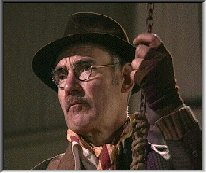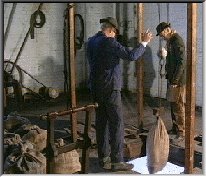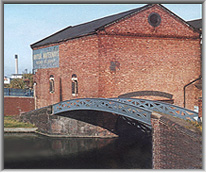Broad Street Warehouse
Inland Waterways Feature
Broad Street Warehouse
Inland Waterways Feature
Background
In recent years, as part of town and city regeneration schemes, many old buildings have been refurbished and re-used. While the exterior is often retained, the interior of such buildings is usually gutted and replaced with modern fixtures and fittings. In 1996 Broad Street Warehouse, at the top of the Wolverhampton Locks, was destined to be converted into a city-centre night club.
The warehouse, dating from the 1870s and once used by the famous canal carriers Fellows Morton & Clayton, had been used as storage space by British Waterways maintenance teams since it had stopped being used for cargo trans-shipment in the early 1960s.

A small group of enthusiasts, lead by British Waterways' Operations Manager, Glyn Phillips, realised the warehouse was still in it's original condition, complete with the original belt and shaft driven lifting cranes - which only needed a little work to get them going again!
So began the project to record the workings of the warehouse before it was too late - reconstructing the way that boats entered the building's indoor wharf, how they were unloaded and how the warehousemen would have used the lifting machinery.
British Waterways, who owned the building commissioned I.A.Recordings to record the building and the historic cargo handling equipment in action.

British Waterways employees and local volunteers (Glyn Phillips, Tony Gregory and Peter Freakley) dressed in 1930s clothing re-enacted traditional canal cargo handling - unloading a narrowboat laden with barrels and sacks with the belt-driven hoists and cranes as well as unloading a vintage lorry from the road-side wharf.
The record of this re-enactment "Warehouse at Work", edited by Tony Lewery, is available from the "Sight Seen Partnerships" page.
The project would not have been possible without the help of Dr Patrick Thorn, The Black Country Living Museum, British Waterways Birmingham & Black Country, The National Waterways Museum, the Dudley Canal Trust, Ellesmere Port Boat Museum and others.

Key Dates:
1772: Birmingham Canal Navigations Main Line canal to Wolverhampton constructed.
1850: Construction of the railway causes part of the canal to be "chopped off", creating a side basin which the canal company used as an open wharf.
1869: Basin leased to the Shropshire Union Carrying Company.
1870: Current warehouse complex erected with offices, stables and loading bays surrounding the cobbled yard bordering the open canal basin.
1921: Shropshire Union finish carrying, warehouse taken over by the Midland and Coast Company, who were soon to be bought out by Fellows, Morton and Clayton
1948: After nationalisation it became the main distribution centre for the North Western narrow boat fleet. As trade dwindled it ended up simply as a store and base for the canal maintenance gang.
1995: Owners British Waterways look for new tenants to develop it for other uses.
1996: Machinery recorded prior to the conversion of the warehouse into a night club.
The images on this page are taken from the Sight Seen Partnership Co-production - "Warehouse at Work".

